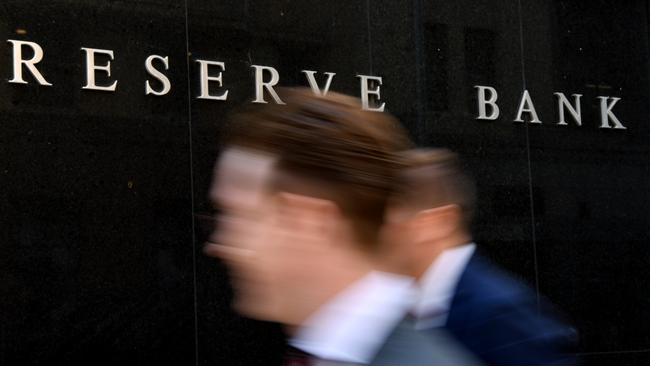Fears negative rates may ‘crash’ system
The nation’s banks are drawing parallels with the Y2K bug ahead of the millennium, and they are looking for a technology workaround

The nation’s banks are scrambling to prepare for the prospect of negative interest rates washing over the economy, despite recent assurances by the Reserve Bank that such a move is “unlikely”.
But with many banks operating on ageing technology, senior bankers fear their systems won’t be able to cope with negative rates, drawing parallels with the “Y2K” bug ahead of the millennium, with an urgent need to find a technology workaround.
In recent weeks, banks have been notifying some business customers of a change in their loan documents in the event that interest rates turning negative.
In doing so, banks have said that if a specific reference rate in their loan agreements falls to less than zero, the rate “will be taken to be zero”.
It’s one way of overcoming the problem of bank systems failing to recognise a negative interest rate number, mirroring fears as the new millennium approached in that computer systems could crash because they wouldn’t be able to process dates beyond December 31, 1999.
A Westpac spokesman said larger commercial businesses might be offered loans at interest rates determined by a margin applied to a benchmark rate, such as BBSY — a bid reference rate usually about five basis points above the bank bill swap rate.
“The purpose of the notification (to customers) is to ensure that, in the event that market benchmark rates were to turn negative, zero would be applied for BBSY in any relevant business loan,” the Westpac spokesman said.
The solution could expose Westpac and the Commonwealth Bank to criticism.
If a negative reference rate is “taken to be zero”, the bank’s profit margin, or the premium charged to the customer above the reference rate, would be preserved. Otherwise, the margin would be eroded.
RBA Governor Philip Lowe said last year it was “extraordinarily unlikely” that the cash rate would fall below zero in Australia. But that was before the COVID-19 pandemic crashed the economy.
The guidance was reaffirmed only last month, when minutes of the central bank’s March special board meeting said directors agreed that the 0.25 per cent cash rate was its “effective lower bound” — the point at which any further monetary policy adjustment lower was counter-productive.
“Members had no appetite for negative interest rates in Australia,” the minutes said.
Dr Lowe is scheduled to appear on Thursday at a webcast event with Australian Prudential Regulation Authority chairman Wayne Byres and Australian Securities and Investments Commission chair James Shipton.
One source said that, with key benchmark rates such as the bank bill swap rate trading at about 10 basis points, it was prudent for the banks to prepare for a scenario where they could dip below zero.
This could occur even when the policy rate remained above zero.
Across the Tasman
While benchmark rates had turned negative in some offshore markets, it was more common when the relevant policy rate was also negative.
The Reserve Bank of New Zealand, which oversees a financial system dominated by the major Australian banks, has adopted a different approach.
It flagged last week a possible reduction in the cash rate to the lower bound, which it stressed could be less than zero, if cash hoarding became a problem.
However, this could only occur in 2021, because the RBNZ said in March it would hold the cash rate at 0.25 per cent for the next 12 months.
RBNZ governor Adrian Orr reaffirmed this on Wednesday, saying he did not want official interest rates to go negative “at this point”. Moving to such a position would need to jump a number of hurdles.
“We don’t want to go negative at this point. We’re prepared to if we have to but not until a lot later,” Mr Orr said in an interview with Bloomberg.
The New Zealand central bank has been engaging with the country’s lenders since the middle of last year about their ability to operate in a negative interest-rate environment.
The RBNZ said in January that written responses from chief executives had raised a number of “serious” constraints and concerns, including required changes to loan documentation, technical system issues, tax and accounting considerations, and market conventions for settling negative rate transactions.
“(We are) engaging with the banks and expect them to be taking steps to be operationally prepared for negative interest rates,” the RBNZ said.
The central bank has pronounced itself ready for the unprecedented policy move, launching a “future-proofed” payment settlement system last February which is capable of operating with negative rates and negative-yielding securities.
CBA said it had also advised commercial customers with loans linked to the BBSY that if the benchmark rate was zero or below, it would be taken as zero.
The approach generally applied to new lending only.
A CBA spokesman said it was difficult to predict if reference rates would turn negative.
“The BBSY rate is a market indicator that is not governed by the RBA, although it often moves closely with the RBA cash rate,” he said.
“However, the RBA has been very clear since setting the cash rate to 0.25 per cent that it doesn’t see its rates going to negative and that the current rate will apply for a long time to come.”



To join the conversation, please log in. Don't have an account? Register
Join the conversation, you are commenting as Logout